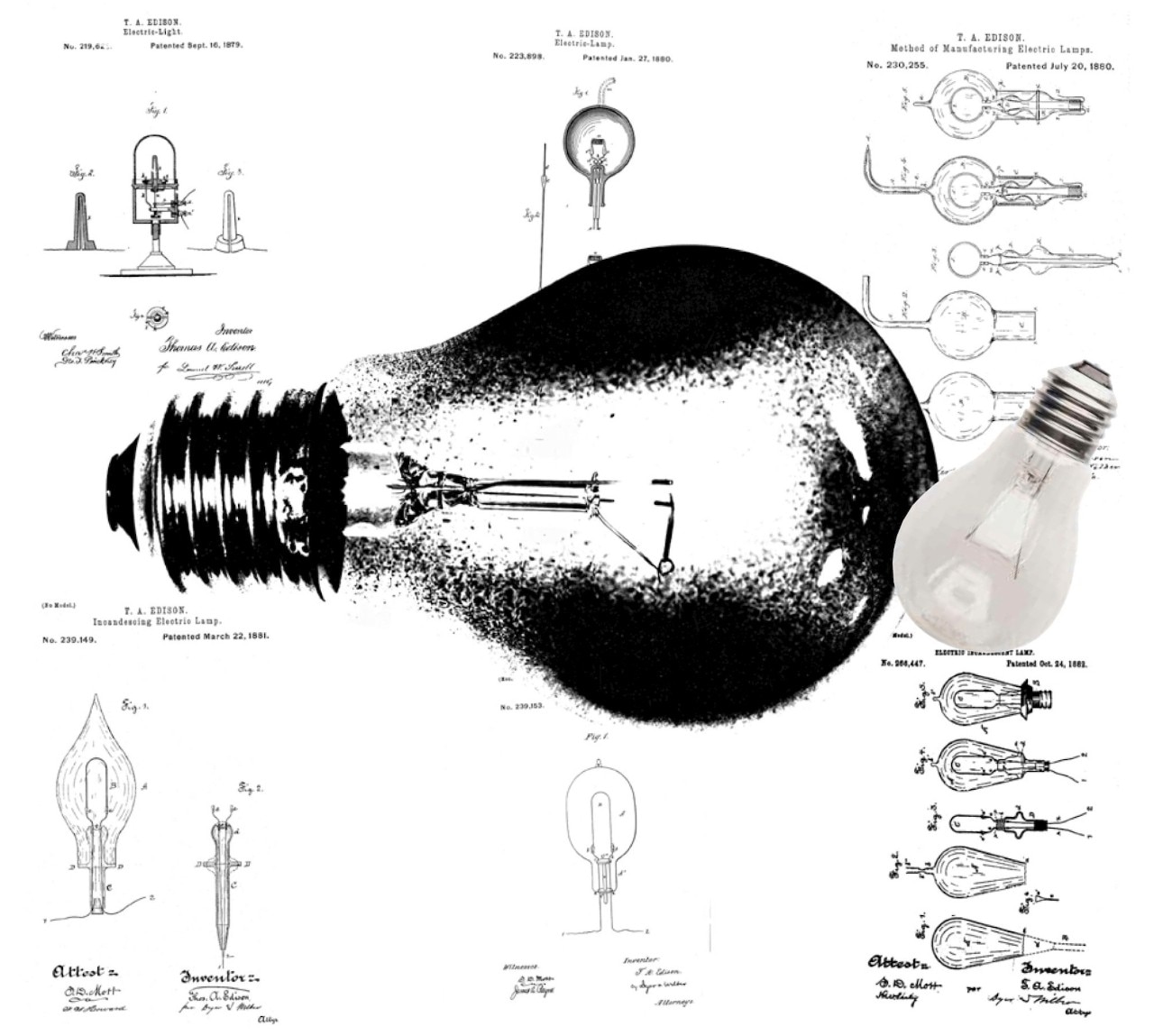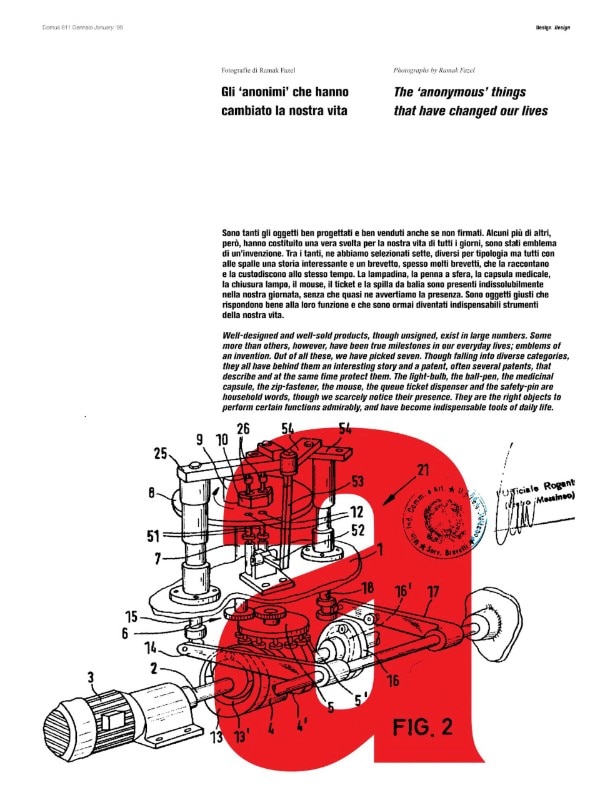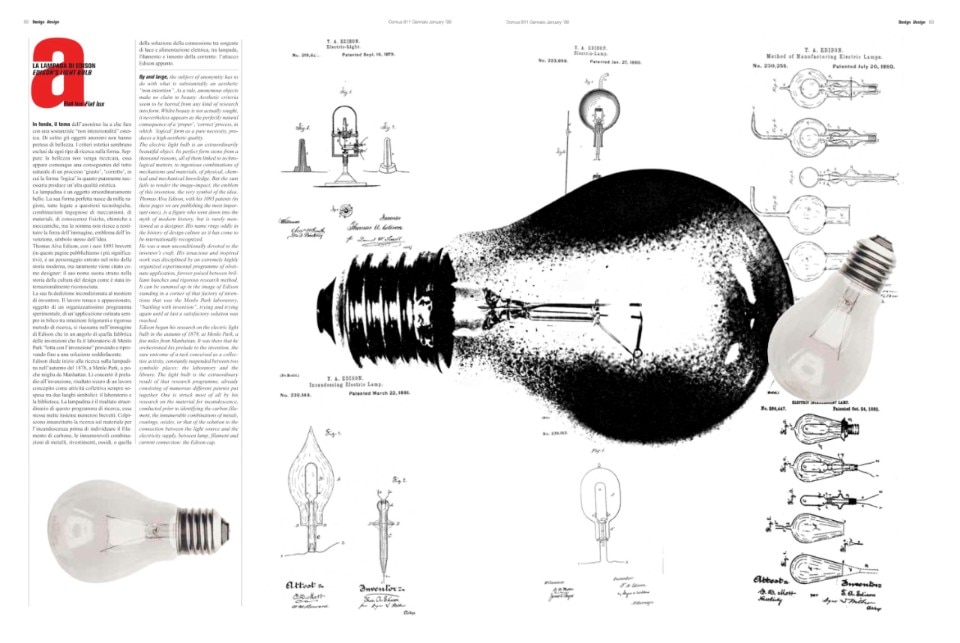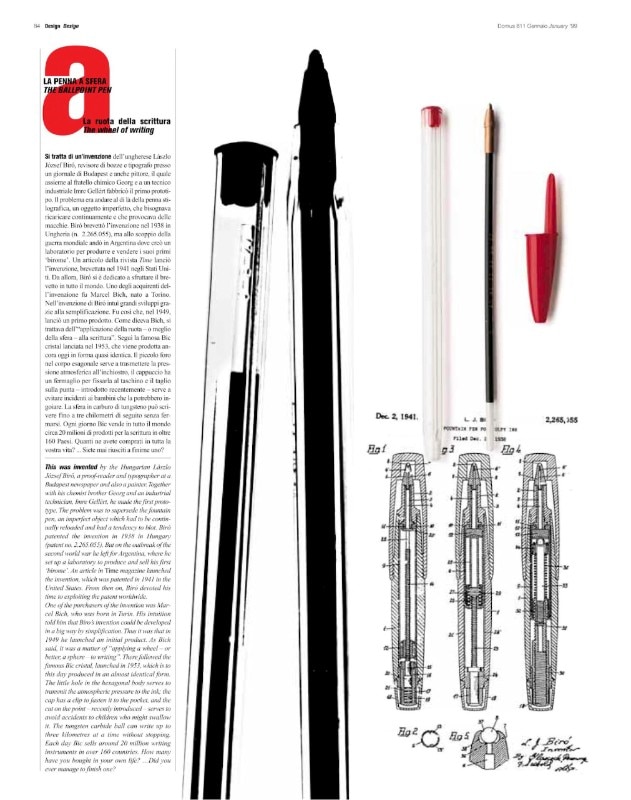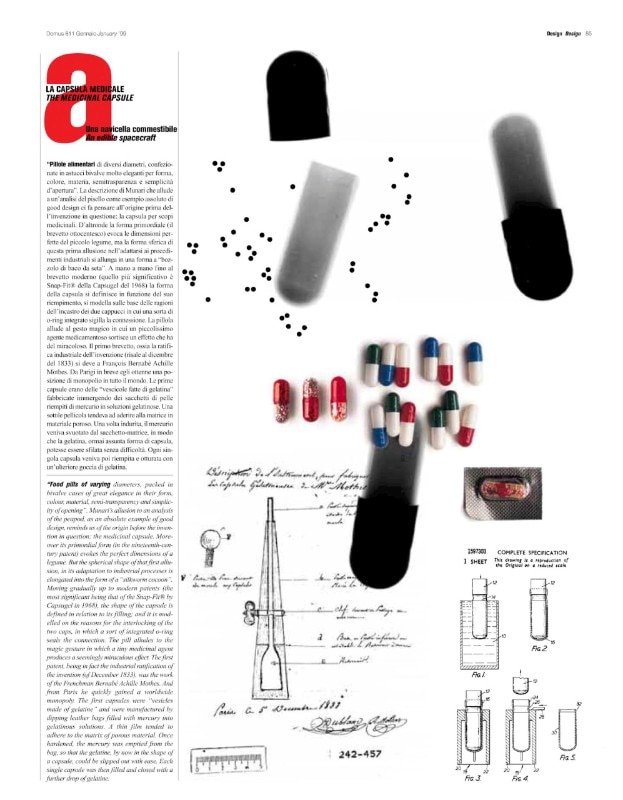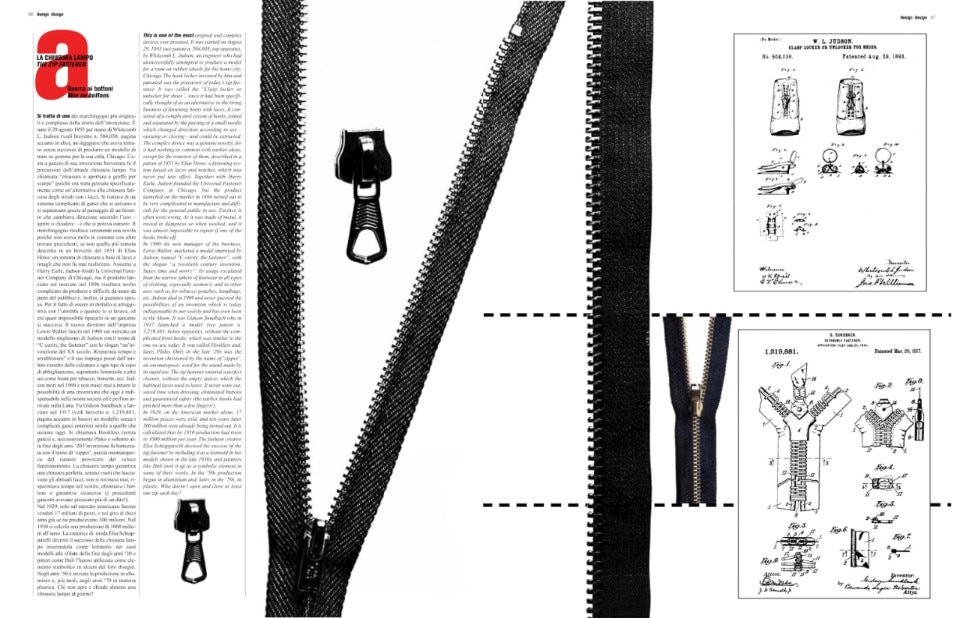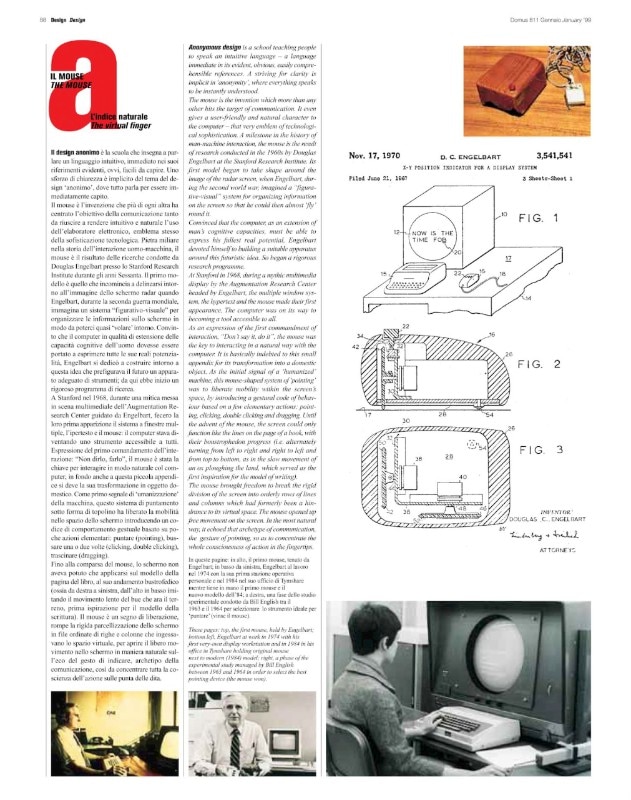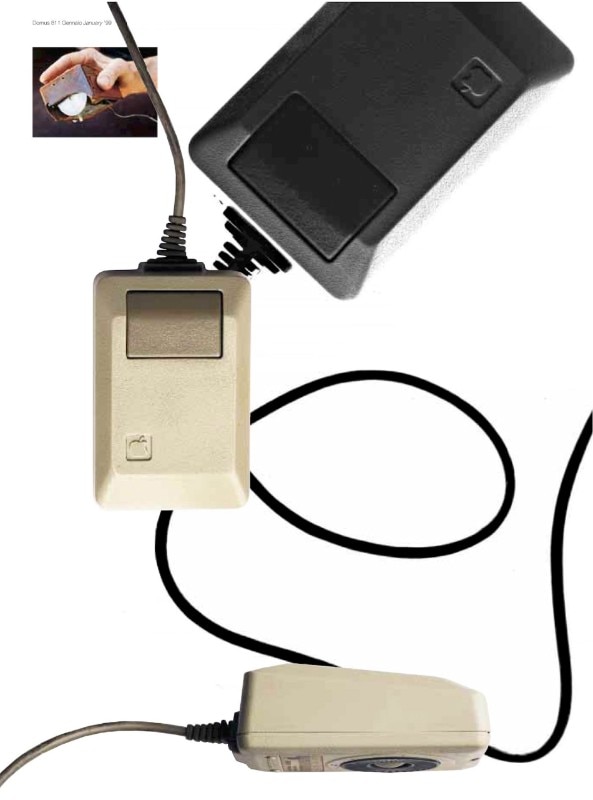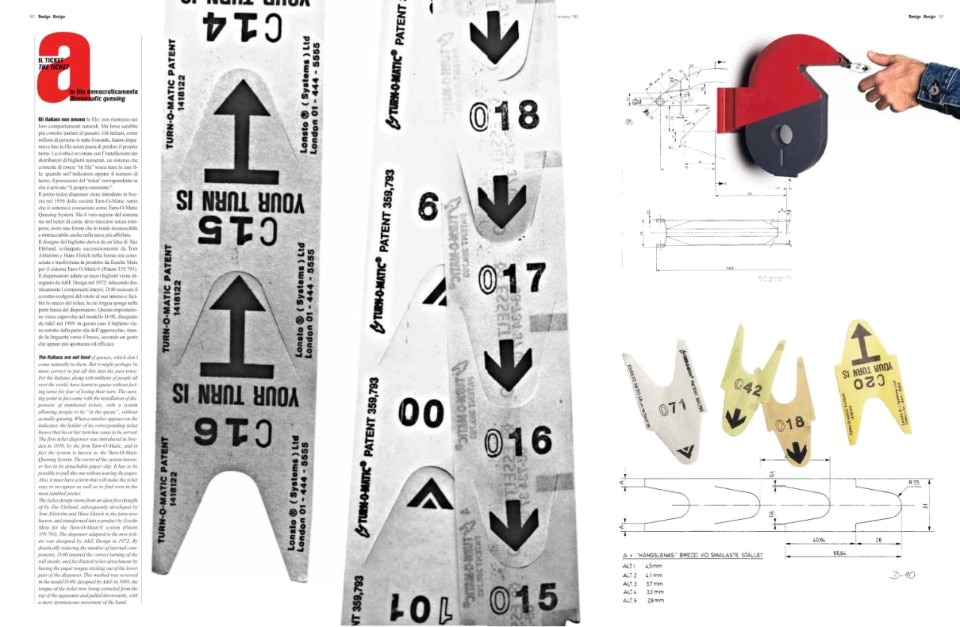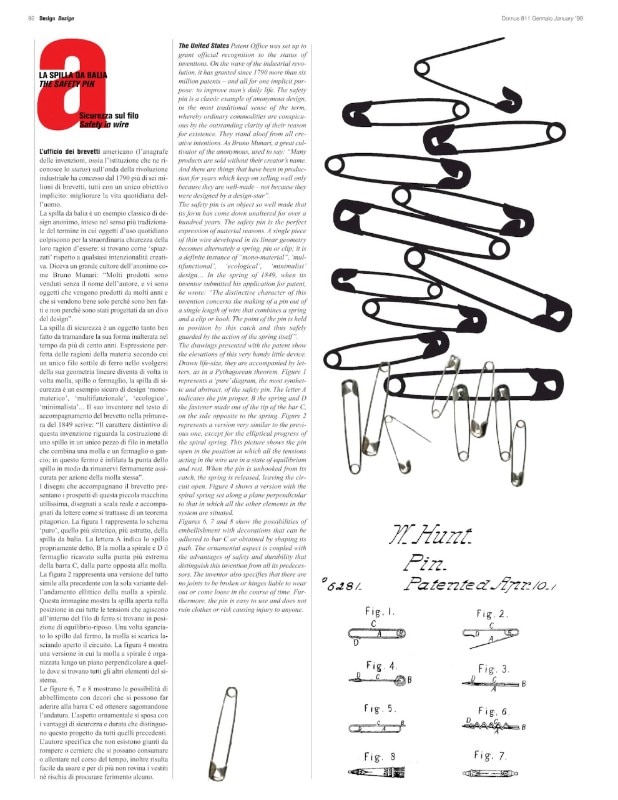This article, whose author is anonymous, was originally published in Domus 811, January 1999.
Well-designed and well-sold products, though unsigned, exist in large numbers. Some more than others, however, have been true milestones in our everyday lives; emblems of an invention. Out of all these, we have picked seven. Though falling into diverse categories, they all have behind them an interesting story and a patent, often several patents, that describe and at the sanse time protect them. The light-bulb, the ball-pen, the medicinal capsule, the zip-fastener, the mouse, the queue ticket dispenser and the safety-pin are household words, though we scarcely notice their presence. They are the right objects to perform certain functions admirably, and have become indispensable tools of daily life.
Edison’s light bulb. Fiat lux
By and large, the subject of anonymity has to do with what is substantially an aesthetic “non-invention”. As a rule, anonymous objects make no claim to beauty. Aesthetic criteria seem to be barred from any kind of research into form. Whilst beauty is not actually sought, it nevertheless appears as the perfectly natural consequence of a ‘proper’, ‘correct’ process, in which ‘logical’ form as a pure necessity, produces a high aesthetic quality.
The electric light bulb is an extraordinarily beautiful object. lts perfect form stems from a thousand reasons, all of them linked to technological matters, to ingenious combinations of mechanisms and materials, of physical, chemical and mechanical knowledge. But the sum fails to render the image-impact, the emblem of this invention, the very symbol of the idea.
Thomas Alva Edison, with his 1093 patents (in these pages we are publishing the most important ones), is a figure who went down into the myth of modem history, but is rarely mentioned as a designer. His name rings oddly in the history of design culture as it has come to be internationally recognized.
He was a man unconditionally devoted to the inventor’s craft. His tenacious and inspired work was disciplined by an extremely highly organized experimental programme of obstinate application, forever poised between brilliant hunches and rigorous research method. It can be summed up in the image of Edison standing in a corner of that factory of inventions that was the Menlo Park laboratory, “battling with invention”, trying and trying again until at last a satisfactory solution was reached.
Edison began his research on the electric light bulb in the autumn of 1878, at Menlo Park, a few miles from Manhattan. It was there that he orchestrated his prelude to the invention, the sure outcome of a task conceived as a collective activity, constantly suspended between two symbolic places: the laboratory and the library. The light bulb is the extraordinary result of that research programme, already consisting of numerous different patents put together. One is stuck most of all by his research on the material for incandescence, conducted prior to identifying the carbon filament, the innumerable combinations of metals, coatings, oxides, or that of the solution to the connection between the light source and the electricity supply, between lamp, filament and current connection: the Edison cap.
The Ballpoint pen. The wheel of writing
This was invented by the Hungarian Làszlo József Biró, a profs-reader and typographer at a Budapest newspaper and also a painter. Together with his chemist brother Georg and an industrial technician, Imre Gellért, he made the first prototype. The problem was to supersede the fountain pen, an imperfect object which had to be continually reloaded and had a tendency to blot. Biró patented the invention in 1938 in Hungary (patent no. 2.265.055). But on the outbreak of the second world war he left for Argentina, where he set up a laboratory to produce and sell his first ‘birome’. An article in Time magazine launched the invention, which was patented in 1914 in the United States. From then on, Biró devoted this time to exploiting the patent worldwide. One of the purchasers of the invention war Marcel Bich, who was born in Turin. His intuition told him that Biró’s invention could be developed in a bug way by simplification. Thus it was that in 1949 he launched an initial product. As Bich said, it was a matter of “applying a wheel — or better, a sphere — to writing”. There followed the famous Bic cristal, launched in 1953, which is to this day produced in an almost identical form. The little hole in the hexagonal body serves to transmit the atmospheric pressure to the ink; the cap has a clip to fasten it to the pocket, and the cut on the point — recently introduced — serves to avoid accidents to children who might swallow it. The tungsten carbide ball can write up to three kilometers at a time without stopping. Each day Bic sells around 20 million writing instruments in over 160 countries. How many have you bought in your own life? …Did you ever manage to finish one?
The medical capsule. An edible spacecraft
“Food pills of varying diameters, packed in bivalve cases of great elegance in their form, colour, material, semi-transparency and simplicity of opening”. Munari’s allusion to an analysis of the peapod, as an absolute example of good design, reminds us of the origin before the invention in question: the medicinal capsule. Moreover its primordial firm (in the nineteenth-century patent) evokes the perfect dimensions of a legume. But the spherical shape of that first allusion, in its adaptation to industrial processes is elongated into the form of a “silkworm cocoon”. Moving gradually up to modern patents (the most significant being that of the Snap-Fit® by Capsugel in 1968), the shape of the capsule is defined in relation to its filling; and it is modelled on the reasons for the interlocking of the two caps, in which a sort of integrated o-ring seals the connection. The pill alludes to the magic gesture in which a tiny medicinal agent produces a seemingly miraculous effect. The first patent, being in fact the industrial ratification of the invention (of December 1833), was the work of the Frenchman Bernabé Achille Mothes. And from Paris he quickly gained a worldwide monopoly. The first capsules were “vesicles made of gelatine” and were manufactured by dipping leather bags filled with mercury into gelatinous solutions. A thin film tended to adhere to the matrix of porous material. Once hardened, the mercury was emptied from the bag, so that the gelatine, by now in the shape of a capsule, could be slipped out with ease. Each single capsule was then filled and closed with a further drop of gelatine.
The zip fastener. War on buttons
This is one of the most original and complex devices ever invented. It was started on August 29, 1893 (see patent n. 504,038, top opposite), by Whitcomb L. Judson, an engineer who had unsuccessfully attempted to produce a model for a tram on rubber wheels for his home city Chicago. The hook locker invented by him and patented was the precursor of today’s zip fastener It was called the “Clasp locker or unlocker for shoes”, since it had been specifically thought of as an alternative to the tiring business of fastening boots with laces. It consisted of a complicated system of hooks, joined and separated by the passing of a small needle which changed direction according to use opening or closing — and could be extracted. The complex device was a genuine novelty, for it had nothing in common with earlier ideas, except for the remotest of them, described in a patent of 1851 by Elias Howe: a fastening system based on laces and notches, which was never put into effect. Together with Harry Earle, Judson founded the Universal Fastener Company in Chicago, but the product launched on the market in 1896 turned out to be very complicated to manufacture and difficult for the general public to use. Further, it often went wrong. As it was made of metal, it rusted in dampness or when washed, and it was almost impossible to repair if one of the hooks broke off. In 1900 the new manager of the business, Lewis Walker, marketed a model improved by Judson, named “C-curity, the fastener”, with the slogan “a twentieth century invention. Saves time and worry”. Its usage escalated from the narrow sphere of footwear to all types of clothing, especially women’s, and to other uses such as for tobacco pouches, handbags, etc. Judson died in 1909 and never guessed the possibilities of an invention which is today indispensable to our society and has even been to the Moon. It was Gideon Sundhach who in 1917 launched a model (see patent n. 1,219,881, below opposite), without the complicated front hooks, which was similar to the one we use today. It was called Hookless and, later, Plako. Only in the late ‘20s was the invention christened by the name of ‘zipper’, an onomatopoeic word for the sound made by its rapid use. The zip fastener ensured a perfect closure, without the empty spaces which the habitual laces used to leave. It never wore out, saved time when dressing, eliminated buttons and guaranteed safety (the earlier hooks had pinched more than a few fingers!).
In 1929, on the American market alone, 17 million pieces were sold, and ten years later 300 million were already being turned out. It is calculated that by 1950 production had risen to 1000 million per year. The fashion creator Elsa Schiapparelli decreed the success of the zip fastener by including it as a leitmotif in her models shown in the late 1930s, and painters like Dalì took it up as a symbolic element in some of their works. In the ‘50s production began in aluminium and, later, in the ‘70s, in plastic. Who doesn’t open and close at least one zip each day?
The mouse. The virtual finger
Anonymous design a school teaching people to speak an intuitive language — a language immediate in its evident, obvious, easily comprehensible references. A striving for clarity is implicit in ‘anonymity’, where everything speaks to be instantly understood.
The mouse is the invention which more than any other hits the target of communication. It even gives a user-friendly and natural character to the computer — that very emblem of technological sophistication. A milestone in the history of man-machine interaction, the mouse is the result of research conducted in the 1960s by Douglas Engelbart at the Stanford Research Institute. Its first model began to take shape around the image of the radar screen, when Engelbart, during the second world war; imagined a “figurative-visual” system for organizing it formation on the screen so that he could then almost ‘fly’ round it. Convinced that the computer as an extension of man’s cognitive capacities, must be able to express his fullest real potential, Engelbart devoted himself to building a suitable apparatus around this futuristic idea. So began a rigorous research programme.
At Stanford in 1968, during a mythic multimedia display by the Augmentation Research Center headed by Engelbart, the multiple window system, the hypertext and the mouse made their first appearance. The computer was on its way to becoming a tool accessible to all. As an expression of the first commandment of interaction, “Don’t say it, do it”, the mouse was the key to interacting in a natural way with the computer. It is basically indebted to this small appendix for its transformation into a domestic object. As the initial signal of a ‘humanized’ machine, this mouse-shaped system of ‘pointing’ was to liberate mobility within the screen’s space, by introducing a gestural code of behaviour based on a few elementary actions: pointing, clicking, double clicking and drugging. Until the advent of the mouse, the screen could only function like the lines on the page of a book, with their boustrophedon progress (i.e. alternately turning from left to right and right to left and from top to bottom, as in the slow movement of an ox ploughing the land, which served as the first inspiration for the model of writing).
The mouse brought freedom to break the rigid division of the screen into orderly rows of lines and columns which had formerly been a hindrance to its virtual space. The mouse opened up free movement on the screen. In the most natural way it echoed that archetype of communication, the gesture of pointing so as to concentrate the whole consciousness of action in the fingertips.
The ticket. Democratic queuing
The Italians are not fond of queues, which don’t come naturally to them. But it might perhaps be more correct to put all this into the past tense. For the Italians, along with millions of people all over the world, have learnt to queue without feeling tense for fear of losing their turn. The turning-point in fact came with the installation of dispensers of numbered tickets, with a system allowing people to be “in the queue”, without actually queuing. When a number appears on the indicator, the holder of its corresponding ticket knows that his or her turn has come to be served.
The first ticket dispenser was introduced in Sweden in 1956, by the firm Turn-O-Matic, and in fact the system is known as the Turn-O-Matic Queuing System. The secret of the system however lies in its detachable paper slip. It has to be possible to pull this out without tearing the paper. Also, it must have a form that will make the ticket easy to recognize as well as to find even in the most jumbled pocket.
The ticket design stems from an idea first thought of by Ake Ehrlund, subsequently developed by Tom Ahlstrom and Hans Ehrich in the form now known, and transformed into a product by Esselte Meto for the Turn-O-Matic® system (Patent 359.793). The dispenser adapted to the new tickets was designed by A&E Design in 1972. By drastically reducing the number of internal components, D-80 ensured the correct turning of the roll inside, and facilitated ticket detachment by having the paper tongue sticking out of the lower part of the dispenser. This method was reversed in the model D-90, designed by A&E in 1989, the tongue of the ticket now being extracted from the top of the apparatus and pulled downwards, with a more spontaneous movement of the hand.
The safety pin. Safety in wire
The United States Patent Office was set up to grant official recognition to the status of inventions. On the wave of the industrial revolution, it has grunted since 1790 more than six million patents — and all for one implicit purpose: to improve man’s daily life. The safety pin is a classic example of anonymous design, in the most traditional sense of the term, whereby ordinary commodities are conspicuous by the outstanding clarity of their reason for existence. They stand aloof from all creative intentions. As Bruno Munari, a great cultivator of the anonymous, used to say: “Many products are sold without their creator’s name. And there are things that have been in production for years which keep on selling well only because they are well-made — not because they were designed by a design-star”.
The safety pin is an object so well made that its form has come down unaltered for over a hundred years. The safety pin is the perfect expression of material reasons. A single piece of thin wire developed in its linear geometry becomes alternately a spring, pin or clip; it is a definite instance of ‘mono-material’, ‘multifunctional’, ‘ecological’, ‘minimalist’ design... In the spring of 1849, when its inventor submitted his application for patent, he wrote: “The distinctive character of this invention concerns the making of a pin out of a single length of wire that combines a spring and a clip or hook. The point of the pin is held in position by this catch and thus safely guarded by the action of the spring itself”.
The drawings presented with the patent show the elevations of this very handy little device. Drawn life-size, they are accompanied by letters, as in a Pythagorean theorem. Figure 1 represents a ‘pure’ diagram, the most synthetic and abstract, of the safety pin. The letter A indicates the pin proper, B the spring and D the fastener made out of the tip of the bar C, on the side opposite to the spring. Figure 2 represents a version very similar to the previous one, except for the elliptical progress of the spiral spring. This picture shows the pin open in the position in which all the tensions acting in the wire are in a state of equilibrium and rest. When the pin is unhooked from its catch, the spring is released, leaving the circuit open. Figure 4 showy a version with the spiral spring set along a plane perpendicular to that in which all the other elements in the system are situated.
Figures 6, 7 and 8 show the possibilities of embellishment with decorations that can be adhered to bar C or obtained by shaping its path. The ornamental aspect is coupled with the advantages of safety and durability that distinguish this invention front all its predecessors. The inventor also specifies that there are no joints to be broken or hinges liable to wear out or come loose in the course of time. Furthermore, the pin is easy to use and does not ruin clothes or risk causing injury to anyone.


